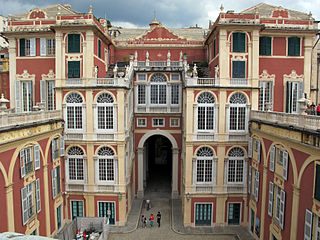This article needs additional citations for verification .(April 2019) |
| Il trono e la seggiola | |
|---|---|
| Directed by | Augusto Genina |
Release date |
|
| Country | Italy |
| Language | Italian |
Il trono e la seggiola is a 1918 Italian film directed by Augusto Genina.
This article needs additional citations for verification .(April 2019) |
| Il trono e la seggiola | |
|---|---|
| Directed by | Augusto Genina |
Release date |
|
| Country | Italy |
| Language | Italian |
Il trono e la seggiola is a 1918 Italian film directed by Augusto Genina.

Johann(es) Simon Mayr, also known in Italian as Giovanni Simone Mayr or Simone Mayr, was a German composer. He was an early inspiration to Rossini.
Abu 'Abd Allah Muhammad b. 'Abd Allah b. Masarra b. Najih al-Jabali (883–931), was an Andalusi Muslim ascetic and scholar. He is considered one of the first Sufis as well as one of the first philosophers of Al-Andalus.

Tullio Carminati was an Italian actor.

Augusto Genina was an Italian film pioneer. He was a movie producer and director.

Carmine Gallone was an early acclaimed Italian film director, screenwriter, and film producer, who was also controversial for his works of pro-Fascist propaganda and historical revisionism. Considered one of Italian cinema's top early directors, he directed over 120 films in his fifty-year career between 1913 and 1963.
"Celeste Aida" is a romanza from the first act of the opera Aida by Giuseppe Verdi. It is preceded by the recitative "Se quel guerrier io fossi!". The aria is sung by Radamès, a young Egyptian warrior who wishes to be chosen as a commander of the Egyptian army. He dreams of gaining victory on the battlefield and also of the Ethiopian slave girl, Aida, with whom he is secretly in love.

Oreste Bilancia was an Italian film actor.
Trono may refer to:

Creatura nuda is the first album from Italian singer Valentina Giovagnini. It was released on 15 March 2002.

Julian Marcus Daang Trono is a Filipino actor, dancer, choreographer and media personality. He is a contract artist of VIVA Artists Agency.

Antonio del Massaro da Viterbo, or Antonio da Viterbo, nicknamed il Pastura was an Italian painter.

'El Trono de México' is a Regional Mexican band from the Mexico state, founded in 2004. El Trono de México began its career with "Registros Skalona". They released the albums Dos veces Mexicano (2004), El pesudo (2005), El muchacho alegre (2006), and Fuego Nuevo (2007). The last two albums contain the biggest hits of the group: "No Te Apartes de Mi", "Ganas de Volver Amar", and "Se Fue". They were one of the biggest Duranguense artists during the genre’s heyday in the mid to late 2000s. In more recent years, they have also recorded songs in the Tierra Caliente style.

The Palazzo Reale or Palazzo Stefano Balbi is a major palace in Genoa.

Marino Moretti was an Italian poet and author.

Valentina Nappi is an Italian pornographic movie actress and adult model.

Pompeo Marino Molmenti was an Italian painter.

Roberto Andò is an Italian director, screenwriter, playwright and author.
The Race to the Throne is a 1919 Italian silent film directed by Roberto Roberti and starring Tilde Kassay.

Enthroned Madonna Adoring the Sleeping Christ Child is a 1475 tempera on panel painting by Giovanni Bellini, now in the Gallerie dell'Accademia in Venice, which acquired it in 1812.

Madonna and Child with Saint Sebastian and Saint Vincent Ferrer or Madonna and Child with Saint Sebastian and Saint Thomas Aquinas oil on panel painting by Andrea Previtali. It was produced in 1506 in Venice while he was still in the studio of Giovanni Bellini and is contemporary with the same artist's Madonna and Child. It is now in the Accademia Carrara in Bergamo, to which it passed from Guglielmo Lochis's collection in 1866.